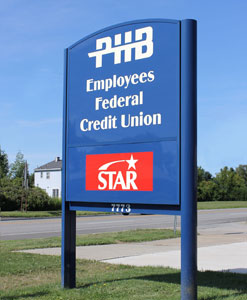Post-and-panel sign systems make up a large portion of the freestanding signage you see on properties today. These signs are perfect fits for applications like wayfinding, site identification, and directional signage.
When considering ideal places to set up a post-and-panel sign system, try to think of places requiring visitor navigation—a campus setting (such as a school or a university), a shopping complex, a business park, a healthcare facility, etc.
Post-and-panel signs are available in a wide variety of configurations—double-post, flag, ceiling, etc.—and they can be customized using paint colors and finishes, decorative posts, designer post caps, word bards, and custom-shaped toppers and panels. LED and incandescent lights can even provide decorative options for some models.
When it comes to posts for these systems, aluminum substrates are strong, lightweight, and non-corrosive. These attributes enable them to withstand a number of weather extremes for years without affecting their appearance.
Aluminum posts can also be mitered and welded, providing the option to display the sign face(s) at different viewing angles.
Meanwhile steel posts can be used for larger signage needs, due to their ability to withstand stronger wind loads.
Aluminum panels can easily be fabricated with radius, peak, slope, or custom-shaped tops and bottoms. These types of panels can also feature routed copy and/or graphics backed with polycarbonate for illumination purposes.
Painted aluminum panels easily accept applied cut vinyl letters and logos and routed letters and logos.

However two of the latest decorating trends involve either covering entire panels with solvent inkjet-printed vinyl graphics (similar to vehicle wraps) or printing the message(s) directly to the panel substrate using a flatbed printer.
For a successful installation, an installer needs to know the desired sign’s location and the method in which it will be installed. Installation methods include direct embedment, base plate surface mount, wall mount, and ceiling mount, to name a few.
Before attempting any installation, visit the location. Verify that the sign’s placement will be functional and easily read by passing vehicular and/or pedestrian traffic. Check all local codes for compliancy.
Plan ahead and stake the sign area; buried utility lines can quickly become a sign installer’s nightmare.
The size, mounting height, and display angle of the sign are important considerations, as well as passing traffic (both vehicular and pedestrian) readability and signage functionality.
Envisioning the signage project through the eyes of a first-time visitor of the facility or property is the best way to approach wayfinding planning and signage placement. How do you want the visitor to navigate through the facility or property and use post-and-panel sign systems to do so?
Decide what messages and signage placement will provide the best possible navigation throughout the location. Modularity is important. Facilities are often changing and growing; using a modular sign system allows these changes, additions, or repairs to be easily made, extending the life of the signage project.
Post-and-panel signs are very easy to install with the use of standard hand tools and some bags of concrete. However note the placement of the sign. Is it very close to a roadway, inviting passing traffic to throw road debris onto it or plows to pile snow onto or against the sign?
Keep the sign clear of bushes, protecting the sign surface from unwanted scratches. Placement near sprinklers should also be avoided because some recycled water will stain sign finishes.
By Bill Freeman, vice president of Architectural Sales at Howard Industries (howardindustries.com) in Fairview, Pennsylvania.
All photos: Howard Industries.











